I spend a lot of time diving the Great Lakes, and Lake Michigan in particular. I know a lot of people who follow Blueyes Below are not divers themselves. Being able to share what I do with others who haven’t done it is one of the things I really enjoy. I’m often asked, “What’s it like diving Lake Michigan to explore shipwrecks?” So today, I thought I’d provide a look into what it’s like diving in Lake Michigan to explore shipwrecks.
For me, safety is essential and dives actually start from land. Either from my home or out on site, before I get into the water I will have a plan. This will involve thinking through what I want to explore, photograph, and film. There is always room to improvise and react to what I find down below, but having a plan sets boundaries which are then affected by depth and conditions.
Diving Lake Michigan
Spring is often the best time of year for diving in Lake Michigan. It’s extremely cold but the water clarity is very good because the lake hasn’t had time to get clouded up by algae blooms. Sunlight penetrates further which is also helped by the fact the sun is starting to get higher up in the sky. This all leads to increased clarity and light.
Before diving Lake Michigan shipwrecks, I need to know where they are. In some cases, the coordinates are well known, and a buoy is tied to the wreck site. In other cases, I have a general idea of where a ship might be, but I have to locate it first using sonar. I then confirm its location with the ROV. (Remote Operated Vehicle) This ensures, particularly for deep shipwrecks, that I am right above them. In cases where it’s too deep to anchor or where I need to make sure I stay precisely positioned, I use an iPilot. This is a device mounted in n my bow which uses GPS data with an electric trolling motor to keep me stationed right where I want to be.

For shallower wrecks, I can often see them from the surface. It’s not hard to get into the water and then get oriented to go exploring. Deeper wrecks, and the darker the water, this gets more challenging. If the water is deep and dark, it gets much more challenging to find your target accurately. One strategy I use is to attach a 15-pound mushroom anchor to a very long line, (greater than the water depth in which I’m exploring) and drop it down gently. Once I can feel the anchor is on the bottom, I pull it up a few feet so it hangs straight down. Now, I can follow the anchor rope all the way to the target or shipwreck with the ROV. I also have strobe lights on the bottom area of the line to keep track of where I came down in the darkness. This is my lifeline to the surface when diving in person, and helps me avoid getting tangled with the ROV tether.
Prepping for the dive
Depending on the depth, I may use a single scuba tank filled with compressed air for shallow, non-technical dives. This setup is faster and easier to use and get into than my Megolodan Rebreather. With my rebreather, where I’m breathing mostly helium at deep depths, I can safely go much deeper and stay longer. This is a true exploration rig that requires multiple regular scuba tanks filled with a special blend of gas strapped to my sides as my “bail out” in the event my rebreather suffers a malfunction while diving. These tanks are in addition to the rebreather on my back. The entire rig is heavy and bulky and I really feel like an astronaut exploring an unseen world when I’m all strapped in.
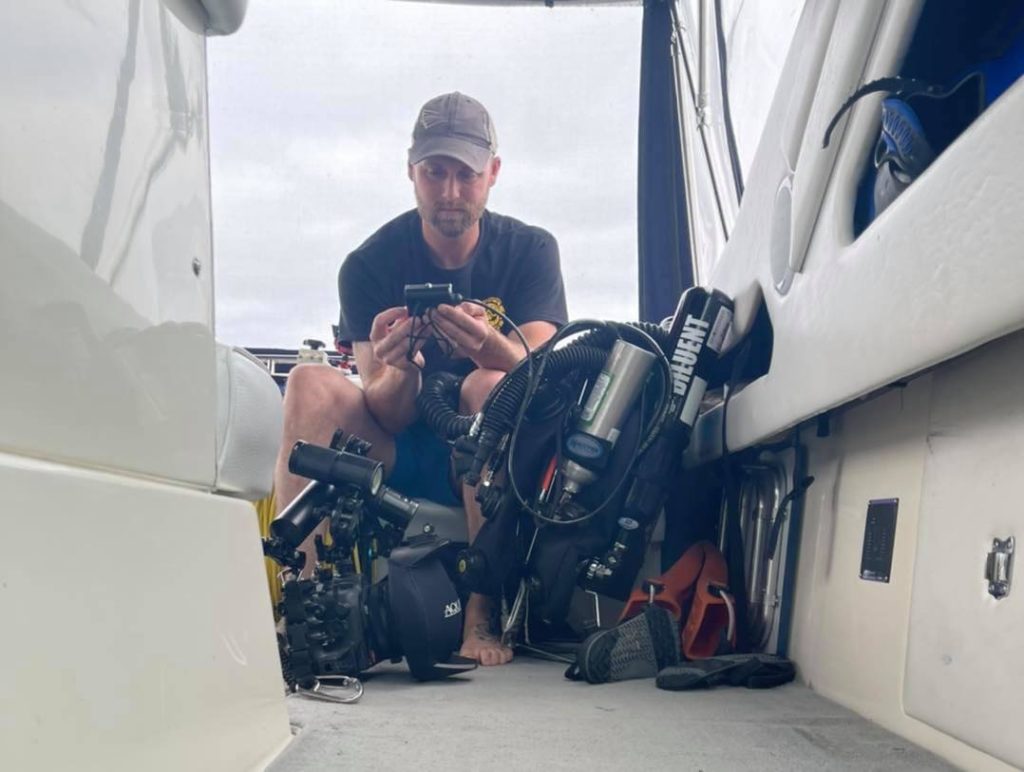
Water pressure builds as you go deeper, and every 33 feet is another atmosphere of pressure. Regular compressed air eventually turns narcotic. Once a diver gets deep enough, they find the need to use specialized gas mixtures, which is why I have to have so many certifications to do what I do. The deeper you go, the more specialized diving becomes.
Using my rebreather on deep dives, the descent procedure is almost like a dance. As I’m going down, I’m equalizing my ears and making sure there’s enough volume to breathe in my counterlungs. This is an important part of my rebreather, on either side of my shoulders and chest that stores an amount of gas that I will typically breathe in or out in a few breaths. It compensates for the pressure. At the same time, the deeper I go the more my dry suit is squeezing me. So now I’m adding air to the dry suit to counteract the effects of the rapidly increasing water pressure.
Then it’s back to equalizing my ears because by then I’m another 20 or 30 feet deeper. This also means I need even more air in my counterlungs because the pressure of this depth has compressed them further. So, the descent is as quick as you can safely manage all of that.
Exploring shipwrecks of the Great Lakes
Once you get close to the bottom, you can’t be going fast and then stop on a dime. As I approach the wreck, I start adding more gas into the suit, counterlungs, and buoyancy control device (BCD). This increases buoyancy and slows the ascent. So when you touch down, you’re not actually touching down and creating a cloud of silt. The goal is to have the transition from diving to exploring be as seamless and smooth as possible and not ruin your visibility for taking photos.
On the descent down, I’m looking for that first glimpse of the wreck. Depending on the day and the clarity of the water and the light, sometimes you can see it from a hundred feet above. Usually, it’s just this dark shape. As you get closer, slowly, you can see more. It’s almost like wearing hazy glasses that slowly sharpen. Eventually, you start to see the details of the wood, the cargo hatches, the masts, and things like that. It’s all in a sort of dusky gloom; enough light to see by, but just barely.
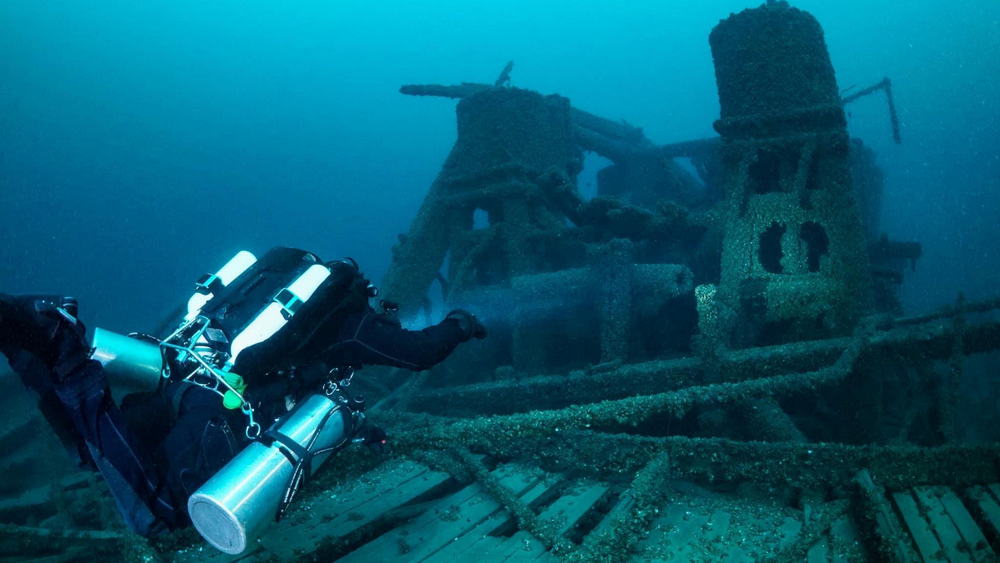
It never gets old. When people normally see a ship, they are usually looking up at it. Say there’s one sailing through a channel, it’s so close you have to look up at it. Or maybe, it’s farther out and you see it from the side. Well with diving, you’re flying. You can go over it, around it, and sometimes even inside of it. It’s just a different world and a completely different experience.
The sheer size of these vessels, as you descend down on them, always surprises me. You’re just so small in comparison to these cargo ships or sailing vessels. Even after seeing so many, it’s really a surprise when you get down there and start exploring them. One of my favorite things is being face-to-face with the bow of a shipwreck. From that perspective, you get an impression of how immense the ship actually is.
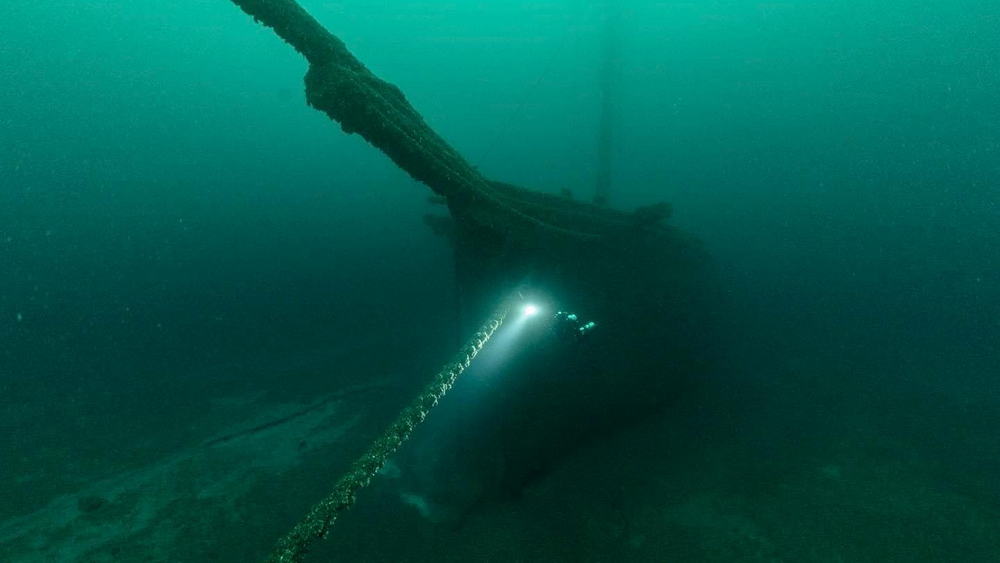
Time below is always limited by depth. The deeper you are, the less bottom time you have. For deep dives, you also have to factor in decompression stops on the way back up. When a diver breathes these compressed gases, it forces nitrogen into their tissues. If you try to release that gas too fast, by ascending too quickly, the nitrogen comes out of a diver’s blood and forms bubbles. This condition is known as “getting the bends.” It’s extremely painful, can cripple a person permanently, and can even lead to death.
I love exploring these old shipwrecks and bringing their stories back for the world to see. It can be dangerous, but like a lot of things people do, you just have to plan and be smart. I’d encourage anyone who wants to give it a try to look up the closest dive shop and find out if anyone is offering lessons.
If you have any questions about where or how to dive in Lake Michigan please look me up on my Facebook page Blueyes Below and send me a message. I hope you enjoyed this look behind the scenes at what it’s like to get down to a shipwreck in the Great Lakes.
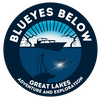
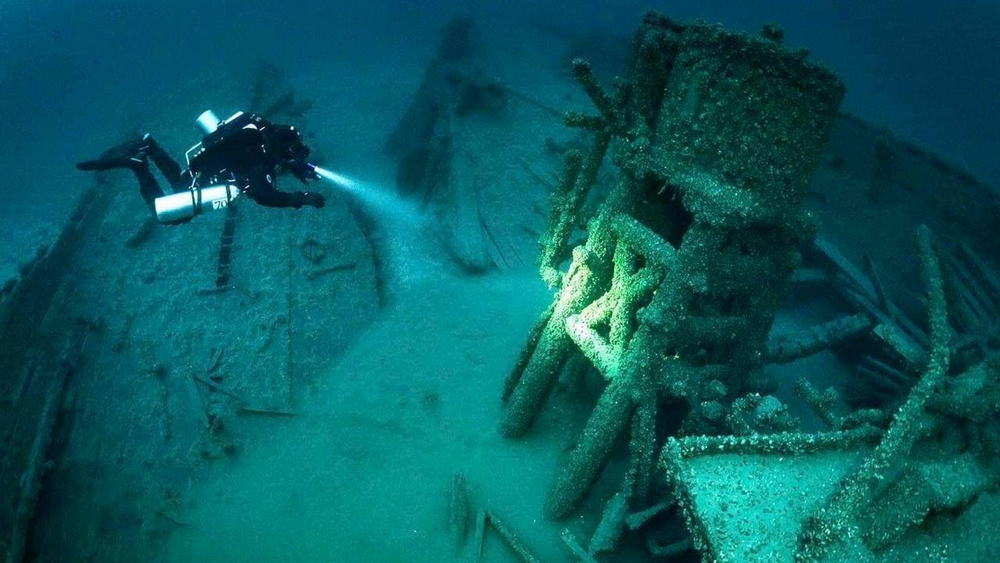
I’m new to your web site but am enjoying it already
Thank you! I enjoy sharing my passion with everyone!
Very interesting and very proud of you buddy
Thanks for always being willing to listen to my adventures!
THANK YOU ! For what you do. I have been watching other videos of wrecks. They lack the artistry, the skill, the passion of capturing the “essence” that you have. You seem to do more with ONE “still” shot than I get from watching others “long video”. Keep it up! Your lighting is unbelievable. As I can afford more, I will support you more.
That is greatly appreciated and wonderful meeting you yesterday!
Without the efforts of you and your friends in the diving community, the Westmorland, like many other wrecks you have discovered and or explored, would be no more than articles in books and magazines, the conditions of which would be up to the imagination of the readers.
The preservation through your photos and video will be part of the history of the Great Lakes shipping industry for generations to come, continuing the life of the vessels long after their usefulness above the water was over.
I’ll say again, the efforts of you and your dive partners “take us places we have never been, and show us things we have never seen.”
Your work is truly appreciated!
Paul, I truly love bringing these ships and their stories to the public. Thank you for your support!
I am so glad to find your site. Growing up in Oceana County, I have always been fascinated by shipwrecks….especially after meeting with the fellows who located the Davodok in the 1970’s. I look forward to following your dives and informative stories.
Thank you for following along! We have plenty more to come.